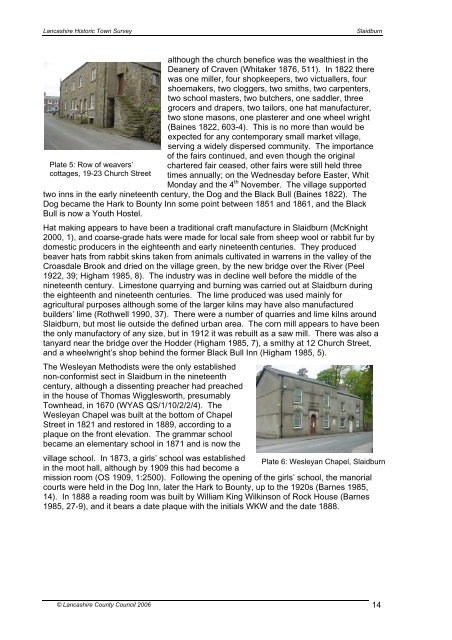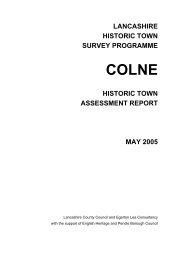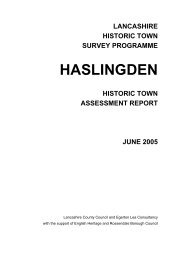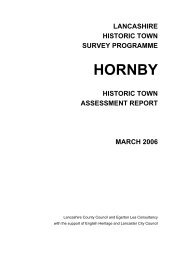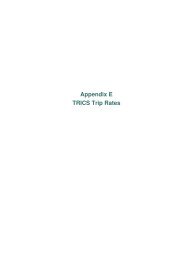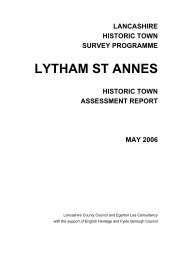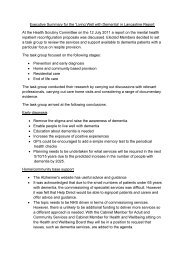SLAIDBURN - Lancashire County Council
SLAIDBURN - Lancashire County Council
SLAIDBURN - Lancashire County Council
You also want an ePaper? Increase the reach of your titles
YUMPU automatically turns print PDFs into web optimized ePapers that Google loves.
<strong>Lancashire</strong> Historic Town SurveySlaidburnPlate 5: Row of weavers’cottages, 19-23 Church Streetalthough the church benefice was the wealthiest in theDeanery of Craven (Whitaker 1876, 511). In 1822 therewas one miller, four shopkeepers, two victuallers, fourshoemakers, two cloggers, two smiths, two carpenters,two school masters, two butchers, one saddler, threegrocers and drapers, two tailors, one hat manufacturer,two stone masons, one plasterer and one wheel wright(Baines 1822, 603-4). This is no more than would beexpected for any contemporary small market village,serving a widely dispersed community. The importanceof the fairs continued, and even though the originalchartered fair ceased, other fairs were still held threetimes annually; on the Wednesday before Easter, WhitMonday and the 4 th November. The village supportedtwo inns in the early nineteenth century, the Dog and the Black Bull (Baines 1822). TheDog became the Hark to Bounty Inn some point between 1851 and 1861, and the BlackBull is now a Youth Hostel.Hat making appears to have been a traditional craft manufacture in Slaidburn (McKnight2000, 1), and coarse-grade hats were made for local sale from sheep wool or rabbit fur bydomestic producers in the eighteenth and early nineteenth centuries. They producedbeaver hats from rabbit skins taken from animals cultivated in warrens in the valley of theCroasdale Brook and dried on the village green, by the new bridge over the River (Peel1922, 39; Higham 1985, 8). The industry was in decline well before the middle of thenineteenth century. Limestone quarrying and burning was carried out at Slaidburn duringthe eighteenth and nineteenth centuries. The lime produced was used mainly foragricultural purposes although some of the larger kilns may have also manufacturedbuilders’ lime (Rothwell 1990, 37). There were a number of quarries and lime kilns aroundSlaidburn, but most lie outside the defined urban area. The corn mill appears to have beenthe only manufactory of any size, but in 1912 it was rebuilt as a saw mill. There was also atanyard near the bridge over the Hodder (Higham 1985, 7), a smithy at 12 Church Street,and a wheelwright’s shop behind the former Black Bull Inn (Higham 1985, 5).The Wesleyan Methodists were the only establishednon-conformist sect in Slaidburn in the nineteenthcentury, although a dissenting preacher had preachedin the house of Thomas Wigglesworth, presumablyTownhead, in 1670 (WYAS QS/1/10/2/2/4). TheWesleyan Chapel was built at the bottom of ChapelStreet in 1821 and restored in 1889, according to aplaque on the front elevation. The grammar schoolbecame an elementary school in 1871 and is now thevillage school. In 1873, a girls’ school was established Plate 6: Wesleyan Chapel, Slaidburnin the moot hall, although by 1909 this had become amission room (OS 1909, 1:2500). Following the opening of the girls’ school, the manorialcourts were held in the Dog Inn, later the Hark to Bounty, up to the 1920s (Barnes 1985,14). In 1888 a reading room was built by William King Wilkinson of Rock House (Barnes1985, 27-9), and it bears a date plaque with the initials WKW and the date 1888.© <strong>Lancashire</strong> <strong>County</strong> <strong>Council</strong> 2006 14


